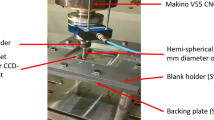Abstract
Knowledge of the residual stress magnitudes induced during the manufacturing process is of interest since these could affect the structural integrity of manufactured parts depending on whether these are in tension or compression. It is also well known that in a wide variety of aerospace components subjected to external loads during work service, only the compressive residual stresses are acceptable. Therefore, the aim of this work focuses on determining residual stresses and their effects created along aluminum parts manufactured by single point incremental sheet forming (SPIF) process. Experimentally, the residual stresses induced during the SPIF process of the formed parts are estimated by using the X-ray diffraction technique on the inner and outer surfaces. It was found that the recorded residual stresses were changing from tensile to compressive ones along the formed part which is an indication of bending effects. Analytical evaluation of these effects reveals that the magnitude of the bending stress distribution is significant when compared to the material yield stress. Furthermore, the variation of sheet thickness was recorded in the same regions at which the XRD measurements were recorded. Experimental data show that there is a correlation between the residual and bending stress distributions with respect to the variation of the sheet thickness that affects the microstructural evolution of the aluminum parts.
Similar content being viewed by others
References
Jeswiet J, Geiger M, Engel U, Kleiner M, Schikorra M, Duflou J, Neugebauer R, Bariani P, Bruschi S (2008) Metal forming progress since 2000. CIRP J Manuf Sci Technol 1:2–17
Lihui L, Kangning L, Cai G, Yang X, Guo C, Bu G (2014) A critical review on special forming processes and associated research for lightweight components based on sheet and tube materials. Manufacturing Rev 1:9
Tanaka S, Nakamura T, Hayakawa K, Nakamura H, Motomura K (2007) Residual stress in sheet metal parts made by incremental forming process. AIP Conference Proceedings 908:775–780
Bambach M, Taleb Araghi B, Hirt G (2009) Strategies to improve the geometric accuracy in asymmetric single point incremental forming. Prod Eng Res Devel 3:145–156
Radu, C (2010) Analysis of the correlation accuracy-distribution of residual stresses in the case of parts processed by SPIF. Mathematical models and methods in modern science. Proceedings of the 14th WSEAS International Conference on Mathematical Methods, Computational Techniques and Intelligent Systems, Portugal, 195–199
Radu C, Tampu C, Cristea I, Chirita B (2013) The effect of residual stresses on the accuracy of parts processed by SPIF. Mater Manuf Process 28:572–576
Radu C, Herghelegiu E, Tampu C, Cristea I (2013) The residual stress state generated by single point incremental forming of aluminum metal sheets. Appl Mech Mater 371:148–152
Mohammadi, A, Vanhove, H, Van Bael, A, Seefeldt, M, and Duflou, JR (2014) The effect of laser radiation on the residual stress levels of single point incrementally formed (SPIF) parts, International Workshop on Thermal Forming and Welding Distortion, Bremen, 83–92
Singh A, Agrawal A (2015) Investigation of surface residual stress distribution in deformation machining process for aluminum alloy. J Mater Process Tech. 225:195–202
Grellner F, Höscheler S, Greil P, Sindel J, Petschelt A (1997) Residual stress measurements of computer aided design/computer aided manufacturing (CAD/CAM) machined dental ceramics. J Mater Sci 32:6235–6242
Hutchings MT, Withers PJ, Holden TM, Lorentzen T (2005) Introduction to the characterization of residual stress by neutron diffraction. Taylor & Francis Group, LLC
Young D, Jeswiet J (2004) Wall thickness variations in single-point incremental forming. J Eng Manufact Part B 218:1453–1459
Emmens WC, van der Boogaard AH (2009) An overview of stabilizing deformation mechanisms in incremental sheet forming. J Mater Process Tech 209:3688–3695
He S, Gu J, Sol H, Van Bael A, Van Houtte P, Tunckol Y, Duflou J (2007) Determination of strain in incremental sheet forming process. Key Eng Mat 344:503–510
Flores P, Duchêne L, Bouffioux C, Lelotte T, Henrard C, Pernin N, Van Bael A, He S, Duflou J, Habraken AM (2007) Model identification and FE simulations: effect of different yield loci and hardening laws in sheet forming. Int J Plasticity 23:420–449
Ji YH, Park JJ (2008) Formability of magnesium AZ31 sheet in the incremental forming at warm temperature. J. Mater. Process Tech. 201:354–358
Chakrabarty J (2006) Theory of plasticity. Butterworth-Heinemann
Marciniak Z, Duncan JL, Hu SJ (2002) Mechanics of sheet metal forming. Butterworth-Heinemann
Silva MB, Skjoedt M, Martins PAF, Bay N (2008) Revisiting the fundamentals of single point incremental forming by means of membrane analysis. Int J Mach Tool Manu 48:73–83
Fang Y, Lu B, Chen J, Xu DK, Ou H (2014) Analytical and experimental investigations on deformation mechanism and fracture behavior in single point incremental forming. J. Mater. Process Tech. 214:1503–1515
Kalpakjian, S, Schmid, S (2008) Manufacturing processes for engineering materials, 5th Ed., Pearson
Malhotra R, Liang XR, Belytschko T, Cao J (2012) Mechanics of fracture in single point incremental forming. J Mater Process Tech 212:1573–1590
Totten, GE, and MacKenzie, DS (2003) Handbook of aluminum, vol. 1, Physical metallurgy and process, Marcel Dekker, Inc. pp. 211–220
Gottstein, G (2005) Physical foundations of materials science. Springer pp.10–14
Wang J, Fang QF, Zhu ZG (1998) Sensitivity of ultrasonic attenuation and velocity change to cyclic deformation in pure aluminum. Phys Stat Sol (a) 169:43–48
Author information
Authors and Affiliations
Corresponding author
Rights and permissions
About this article
Cite this article
Jiménez, I., López, C., Martinez-Romero, O. et al. Investigation of residual stress distribution in single point incremental forming of aluminum parts by X-ray diffraction technique. Int J Adv Manuf Technol 91, 2571–2580 (2017). https://doi.org/10.1007/s00170-016-9952-y
Received:
Accepted:
Published:
Issue Date:
DOI: https://doi.org/10.1007/s00170-016-9952-y




